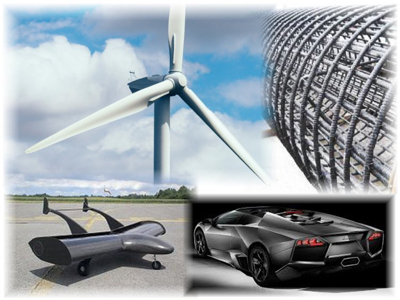What Does the Future of Carbon Fiber Look Like?
 With carbon fiber’s many unique characteristics making it a favorite design choice for engineers today, market projections indicate demand for carbon fiber will continue to grow exponentially in coming years. There is demand for carbon fiber components in just about every high-tech industry these days. Below are just a few of the industries that are finding innovative ways to use carbon fiber every day.
With carbon fiber’s many unique characteristics making it a favorite design choice for engineers today, market projections indicate demand for carbon fiber will continue to grow exponentially in coming years. There is demand for carbon fiber components in just about every high-tech industry these days. Below are just a few of the industries that are finding innovative ways to use carbon fiber every day.
Automotive Manufacturing
Originally targeted only for high-performance vehicles, carbon fiber is being used more often in the commercial automobile industry these days. Using carbon fiber rather than steel for certain vehicle elements can reduce vehicle weight by as much as 60%, allowing for a potential of up to 30% fuel reduction. With government regulations requiring decreased carbon emissions and increased fuel economy each year, growth in this area should remain high. As an added bonus, lighter cars can also reduce the wear and tear on roadways.
Energy Industry
Carbon fiber’s strength and light weight make it an ideal material for fabricating wind turbines and windmill blades. Carbon fiber windmill blades are more rigid and last longer than traditional windmill blades, allowing them to create more energy with less wind. Carbon fiber is also being used in compressed natural gas (CNG) storage and transportation, fuel cells, deep-sea drilling platforms, and drill pipes. The oil and gas industry is particularly interested in exploring new innovations using carbon fiber due to its corrosion resistance, light weight, and high heat tolerance.
Construction
Carbon fiber can be used to create lightweight, precast concrete, providing alternative building materials to traditional steel and aluminum. Carbon fiber’s strength and stiffness properties also make it a great solution for building in areas subject to earthquakes.
Aircraft
From defense to commercial aircraft, drones, and unmanned aerial vehicles (UAVs), carbon fiber is leaving a significant imprint on the aircraft industry. Carbon fiber is an ideal material for multi-rotor helicopters as well. Adding the benefits of both weight reduction and high-tech distinctiveness, using carbon fiber for the interior of aircraft improves efficiency, allows for additional payload, and adds an air of class to the look and feel of a plane.
The Role of Carbon Fiber Manufacturers
As uses for carbon fiber increase, the need for carbon fiber composite manufacturers to create more product will also grow. Therefore, the future of carbon fiber depends largely on the ability of manufacturers to meet demand. There are a few areas where manufacturers can focus their efforts to help the industry meet future demand. These include:
- Developing new carbon fiber applications
- Decreasing manufacturing costs
- Finding ways to increase production, allowing for a reduction in the base cost of carbon fiber (higher volume, lower cost)
- Improving carbon fiber recycling and reuse practices
Carbon Fiber Projections
In 2015, carbon fiber reinforced plastic (CFRP) sales were $2.25 billion. Forecasters predict that number to increase to $48.7 billion by 2020.
Carbon fiber tow sales, which were $1.6 billion in 2011, are expected to increase to around $4.5 billion by 2020. The amount of carbon fiber tow needed for fabrication is projected to grow from 2011’s demand of 46,000 tons to 140,000 tons in 2020.
Wind energy needs are expected to grow from 10,440 tons to 54,270 tons by 2020, increasing it to 46% of the total market. The aerospace and defense industries project an increase in carbon fiber demand from 7,694 tons to 18,462 tons in 2020.
Looking at these numbers, it’s easy to see that carbon fiber is a growing industry, and the demand will continue to increase as new applications are developed. If manufacturers can continue to find ways to decrease manufacturing costs and improve reuse and recycling for carbon fiber waste while keeping up with the demand, the future of carbon fiber could be limitless.
Want to take a look back in time to how carbon fiber got to where it is today? Check out a brief history of carbon fiber here.